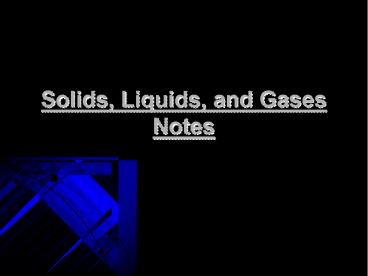Solids, Liquids, and Gases Notes - PowerPoint PPT Presentation
Title:
Solids, Liquids, and Gases Notes
Description:
Solids, Liquids, and Gases Notes I. ... Covalent, ionic, and metallic bonding are intramolecular forces. Metallic bonding is the strongest of the three. – PowerPoint PPT presentation
Number of Views:351
Avg rating:3.0/5.0
Title: Solids, Liquids, and Gases Notes
1
Solids, Liquids, and Gases Notes
2
I. How do solids and liquids differ from gases?
- Solids
- intermolecular forces are sufficiently strong
relative to kinetic energy - molecules are virtually locked in place often in
a very orderly pattern (crystalline structures) - definite volume and shape
3
- Liquids
- attractive intermolecular forces between
molecules is comparable to kinetic energies of
molecules - molecules are held in close proximity, but still
move in a rather chaotic motion - definite volume but no definite shape
- considered a fluid
4
- Gases
- molecules/particles in chaotic motion
- average kinetic energy is greater than the
attractive forces between molecules - have no definite volume or shape
- considered a fluid
5
(No Transcript)
6
- II. Intermolecular Forces (IM) - These are weak
forces that exist between molecules and are
responsible for the fact that the substance can
exist as a liquid (and/or solid). Molecules of
gases have little to no intermolecular forces
(which is why gases have no definite shape or
volume). Dipole-dipole IM forces, London
dispersion, and hydrogen bonding are
intermolecular forces.
7
- IntrAmolecular Forces are the bonds or forces
within the atoms of a molecule the two bonds
connecting two hydrogen atoms to an atom of
oxygen in water are intrAmolecular forces. The
force holding water molecules together so they
dont evaporate are intErmolecular forces and are
about l/6 to l/l0th as strong as single covalent
bonds. Covalent, ionic, and metallic bonding are
intramolecular forces. Metallic bonding is the
strongest of the three.
8
Intramolecular Force
Draw this picture in your notes!
9
Dipole Dipole Forces
10
(No Transcript)
11
Hydrogen Bonding
12
- Practice Problems True or False
- 1. Gases have a definite volume. True or False?
- 2. Solids are considered fluids. True or False?
- 3. Dipole-dipole, London dispersion, and
hydrogen bonding are intermolecular forces. True
or false? - 4. Intermolecular forces describe the forces of
attraction between one molecule and another
molecule. True or false? - 5. Intramolecular forces describe the bonds
between atoms within a molecule. True or false? - 6. Gases have little to no intermolecular forces
so they have no definite shape or volume. True
or false? - 7. Covalent, ionic, and metallic bonding are the
three intramolecular forces. True or False? - 8. Ionic bonds are the strongest of the three
intramolecular forces. True or False?
13
III. Phase Changes
- 1. vaporization (?H) liquid to gas
- 2. condensation (-?H) gas ? liquid
- 3. sublimation (?H) solid ? gas
- 4. deposition (-?H) gas ? solid
- 5. melting (?H) solid ? liquid
- 6. freezing (-?H) liquid ? solid
- Phase changes involve the breaking and forming of
intermolecular forces.
14
(No Transcript)
15
(No Transcript)
16
(No Transcript)
17
(No Transcript)
18
- The phase changes that involve
the breaking of intermolecular forces
of attraction include - melting, vaporization, and
sublimation - These require an input of energy to overcome the
attractive forces between the particles of the
substance.
19
- The phase changes that involve
the forming of intermolecular forces
of attraction include - freezing, condensation, and
deposition - These release energy as the particles adopt a
lower-energy conformation.
20
- The strength of the intermolecular attractions
between molecules, and therefore the amount of
energy required to overcome these attractive
forces (as well as the amount of energy released
when the attractions are formed) depends on the
molecular properties of the substance. Generally,
the more polar a molecule is, the stronger the
attractive forces between molecules are.
21
- Phase Diagrams a graph of pressure VS
temperature that shows the conditions under which
the phases of a substance exist. - Phase Diagram for Water
22
Phase Diagram for Carbon Dioxide
23
(No Transcript)

